Services on Demand
Journal
Article
Indicators
-
 Cited by SciELO
Cited by SciELO -
 Access statistics
Access statistics
Related links
-
 Cited by Google
Cited by Google -
 Similars in
SciELO
Similars in
SciELO -
 Similars in Google
Similars in Google
Share
CT&F - Ciencia, Tecnología y Futuro
Print version ISSN 0122-5383On-line version ISSN 2382-4581
C.T.F Cienc. Tecnol. Futuro vol.2 no.2 Bucaramanga Jan./Dec. 2001
ABSTRACT
Postreatus was grown in a soil mixture contaminated with anthracene, wheat bran I and compost, in varying combinations. Assays with added bacteria and reinocularon of the fungus were also included. The results indicated that in many of the combinations, most of the anthracene was removed at the earliest sample time, 15 days. The most effective combination was spiked (anthracene-added) soil, fungus and compost and the addition of acclimated bacteria to this mixture inhibited anthracene removal. Analyses of extracts by high-pressure liquid chromatography (HPLC) indicated that -anthraquinone, was the major metabolite formed. The results of this study indicate that solid-state fermentation of anthracene-contaminated soils using P. ostreatus in combination with wheat bran and compost additives can produce an accelerated rate of biological removal of anthracene from the soil.
Keywords: PAHs, anthracene, P. ostreatus, biodegradation.
RESUMEN
Pleurotus ostreatus fue crecido en una mezcla de suelo contaminado con antraceno, salvado y compost en varias combinaciones. Los ensayos con bacterias y reinoculación del hongo fueron incluidos. Los resultados indicaron que en la mayoría de las combinaciones el antraceno fue removido en un tiempo de quince días. La combinación más efectiva fue el suelo dopado, hongo y compost; y la adición de bacterias a la mezcla inhibió la remoción del antraceno. Análisis del extracto por cromatografía líquida de alta presión (HPLC) indicaron que la antraquinona, fue el mayor metabolito formado. Los resultados de este estudio indicaron que la fermentación en estado sólido de suelos contaminados con antraceno usando Pleurotus ostreatus en combinación con salvado y compost pueden producir una rata acelerada en la remoción biológica del antraceno del suelo.
Palabras clave: PAHs, antraceno, P. ostreatus, biodegradación.
INTRODUCTION
Biodegradation of anthracene and other high molecular weight polycyclic aromatic hydrocarbons (PAH's) is currently being studied by whole fungal cultures like, P. ostreatus during solid-state fermentation and the effect of Manganese (Kerem, Z. and Hadar, Y. 1995; Sarkar, S., et al, 1997) , P. chrysosporium (Vazquez-Duhalt, R, et al, 1994), Coriolopsis gallica (Pickard, M.,et al, 1999).
In previous studies of the metabolism of anthracene, the dihydrodiol metabolite was an important intermediate during the monoxygenation of the parent compound and it has been demonstrated that low production of C02 correlated with low levels of dihydrodiol formation during the last stage of growth (Cerniglia, C, .et al, 1990; Bezalel et al, 1996 A. Bezalel et al, 1996 B).
During the metabolism of anthracene by P. ostreatus, anthracene trans-1, 2-dihydrodiol has been identified with the accumulation of anthraquinone in the culture medium. Those results indicate that P. ostreatus acts on the anthracene as a non-ligninolytic fungus, i. e, it has the capacity to metabolize the compound although it does not show peroxidase activity (Bezalel et al, 1997). There was no distinct correlation between the activities of lacease, manganese peroxidase and manganese-inhibited peroxidase and PAH mineralization in P. ostreatus cultures.
The highest levels of lacease activity have been measured simultaneously with an increase in levels of C02, and this may be related to the cellular mass and the physiological state in which the fungus produces lacease levels while they are metabolizing PAHs by different mechanisms. Therefore, the lacease can be involved in the later stages of degradation of the PAH metabolites and not necessarily in the initial oxidation of the molecule (Field et al, 1992).
Solid-state fermentation (SSF) has traditionally been used in composting agricultural wastes for mushroom cultivation and the production of organic fertilizers. Straw SSF with ligninolytic fungi increases the enzymatic hydrolysis of polysaccharides and polycyclic aromatic hydrocarbons (PAH's) by the action of enzymes produced. The studies show that the highest removal rates have been obtained with w/w inoculum / soil from 20 to 40% of P. ostreatus on affected soil (White and Lamar 1999). Eggen, T, 1999 report that the most efficient PAH degradation is found during the firs weeks of incubation, and a prolonged incubation time has limited effect. With a soil artificially added benzo(a)pyrene they found it was degraded faster than aged benzo(a)pyrene and pre-treatment of soil before inoculation of fungal substrate, improve the effect of fungal treatment.
In this study, the biological transformation of anthracene in spiked soil, containing the fungus P. ostreatus grown under solid-state fermentation conditions using wheat bran as a substrate with a 10% inoculum percentage of dry weight, was evaluated. We also evaluated anthracene biotransformation using an inoculum of hydrocarbon-biodegrading bacteria alone, as well as together with the fungal inoculum in different combinations and with the addition of compost. Finally, we examined the anthracene breakdown products after 90 days of soil treatment by subjecting soil extracts to high pressure liquid chromatography.
MATERIALS AND METHODS
Culture conditions of the fungus.
Wheat bran (as a natural substrate) was used as the solid support substrate for solid-state Fermentation (SSF) of P. ostreatus. Atypical preparation consisted of 250 g (dry weight) of wheat bran in 3,000 ml bottles to which 250 ml of phosphate buffer pH 6.2 was added. Prior to use, the bottles were sealed and autoclaved at 394K (121°C), and cooled. They were then inoculated with 50 ml of pellet solution grown in Malt broth (0.02g/ml dry weight) taken from 12-day old P. ostreatus cultures. After inoculation and homogenization, the bottles were incubated at 293K (20°C) for 20 days.
Culture conditions of bacteria.
A hydrocarbon-biodegrading consortium of indigenous bacteria was isolated from soil samples contaminated with hydrocarbon at the Biotechnology Laboratory of the Instituto Colombiano del Petróleo (ICP) and used in the experiment. The consortium was grown using a basal saline medium supplemented with growth substrates (glucose 1.8 g and succinate 1.6 g/L) (Vargas et al, 1996). Bacteria were studied in order to be able to compare biodegradation regarding the fungus and/or its synergy.
Biodegradation assay in soil beds.
To evaluate biotransformation of anthracene, the purified compound (96%, Merck) was used. Assays were carried out in soil microcosms using the white rot fungus P. ostreatus grown on bran in SSF and hydrocarbon-degrading bacteria.
Eleven (11) assays were performed to evaluate: 1) the fungi, 2) the bacterial consortium, 3) the interaction between these two groups of organisms, 4) the influence of the compost, and 5) the effect on the test (Table 1). The control test consisted of silt-sand soil spiked with 80 mg/kg of anthracene and the soil plus 5% of vegetable compost (T1 and T2).
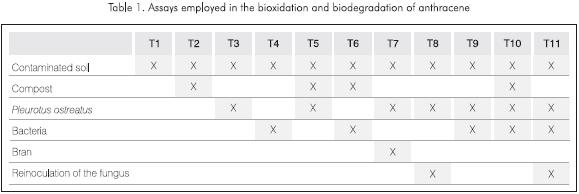
Every 15 days, 10 g of fungus grown in wheat bran were added to tests T8 and T11. Every week, 10 ml of the bacterial consortium were added at a density of 1x10E7 colony-forming units (cfu)/ml to tests T4, T6, T9, T10, T11. The assays were incubated in the dark at a temperature range of 295K - 297K (22-24°C) for 90 days. Soil moisture content was maintained at 50% of soil weight by periodically adding sterile distilled water. Every 15 days, triplicate, 5 g samples of every assays were collected and analyzed for anthracene.
Experimental setup
Five hundred gram aliquots of soil spiked with anthracene at a concentration of 80 ppm were placed in 2-liter jars. Table 1 specifies the amendments added to each of the assays.
Chemical analysis
The anthracene present in a soil sample was separated from the soil matrix by using a Soxhlet micro-extractor composed of a 50-ml flask, a 25-ml sample-holder and a 10-cm long-flask condenser. For each extraction, approximately three g of soil were weighed and placed in a cellulose thimble. The thimble was inserted into the sample-holder and the sample underwent the extraction with a 1:1 acetone: dichloromethane solution for 3 hours with water at 289K (16°C).
The sovent was removed by rotoevaporation at 323K (50°C), at atmospheric pressure, until dryness. The extract was then dissolved in CH2C12 and transferred quantitatively into a 1-ml vial, for subsequent quantification by high-pressure liquid chromatography (HPLC). The analysis of the samples was carried out in a Hewlett Packard 1090 Series II liquid chromatograph equipped with an ultraviolet diode array detector and connected to version A05.01 a ChemStation computerized data system.
The anthracene in each sample was separated on a reverse phase (ODS) chromatographic column (C18) (Supelco Sil L-18, particle size 5 µm, 25cm · 4.6 mm-ID). Anthracene was quantified by comparing the sample peaks to peaks generated by the analysis of five external anthracene standards (19.6, 39.2, 58.8, 78.4 and 98 mg/L).
Qualitative and quantitative analyses were conducted using two criteria simultaneously: chromatographic (retention time) and spectroscopic analysis (UV spectrum). The eluent used was a water-acetonitrile solution. The flow rate was 1 ml/min., and the column temperature was 313K (40°C). The gradient was created by injecting three acetonitrile-water mixtures (i.e., 10:90, 100:0, and 100:0,10:90) at 0,30 and 17 minutes, respectively. The UV absorbencies were monitored at 254 nm.
RESULTS AND DISCUSSION
Metabolism of PAHs by whole fungal cultures has been demonstrated, and at least two mechanisms are involved; one uses the cytochrome P-450 system (Bezalel et al., 1997; Sutherland, J.B., et al., 1995, and the others uses the soluble extracellular enzymes of ligning catabolism, including ligning peroxidases, manganese peroxidase and Lacease (Pickard et al, 1999).
Analytical results of the biodegradation of anthracene in soil.
Table 2 shows the results obtained, where the value for each test corresponds to the average of the triplicates. The standard deviation for the triplicate analyses of each test sampling data ranged from 4% to 15%.
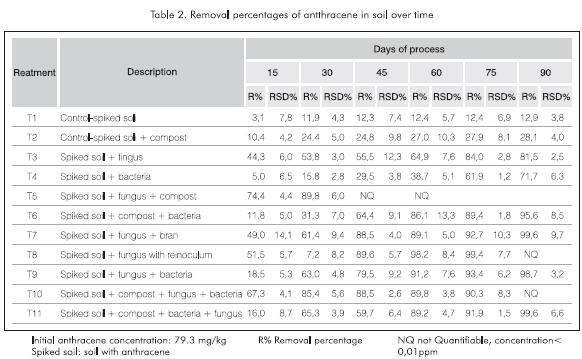
The initial concentration of anthracene in the contaminated soil was 79.3 mg/kg. The maximum removal rate was observed after 15 days in the T5 test (3.92 mg/kg/day), T10 (3.51 mg/kg/day), T8 (2.7 mg/kg/day), T7 (2.55 mg/kg/day) and T3 (2.31 mg/kg/day). These results are important because the data for P. ostreatus fungus supassed that containing only bacteria. The highest valves (tests T5, T10) were favored by the presence of compost when compared with T3 and T8. On the other hand, the last two assays showed the benefit of reinoculating with the fungus (T8). This removal time coincides with the values of enzymatic activity obtained in a solid matrix cultures containing P. ostreatus, in which the lacease peaks occurred after 12 days.
Tests T9 and T11 exhibited maximum removal rates after 30 days with values of 2.44 mg/kg/day and 2.63 mg/kg/day, respectively. Over the second half of the 30-day period, the anthracene removal rates of assays T5 and T10, which during the first 15 days of incubation exhibited the highest removal rates, decreased to 0.82 and 0.97 mg/kg/day, respectively. This reduction in anthracene removal rate may be a consequence of the low availability of the substrate, which had been reduced by 85%. After 45 days, the concentrations of anthracene in the samples from test T5 were below the detection limit for the analytical method.
The tests that contained only bacteria exhibited very low rates of anthracene removal, reaching a maximum velocity of 1.77 ppm/day after 45 days in the case of T6. This result was anticipated due to the fact that the bacteria did not possess the enzymatic capacity of the fungus, which would serve to induce faster oxidation of this type of substrate.
The compost test exhibited an average anthracene removal rate of 26% after 90 days of incubation, whereas the fungal assays plus compost (T5 and T10) exhibited total anthracene removals of 85% to 90% after only 30 days of incubation. This indicates that the addition of the fungus to the compost increased the anthracene removal rate by over 60% (Table 2).
Figure 1 presents the chromatograms for assays T2, T6, T5 and T10 after 15 days of incubation. Assays T5 and T10 were the assays that exhibited the highest anthracene removal rates, assay T2 was the control assays with compost, and assay T6 was the assay that involved soil composted with bacteria. In this case, the peak for anthracene corresponded with the peak that eluted after 11.5 min.
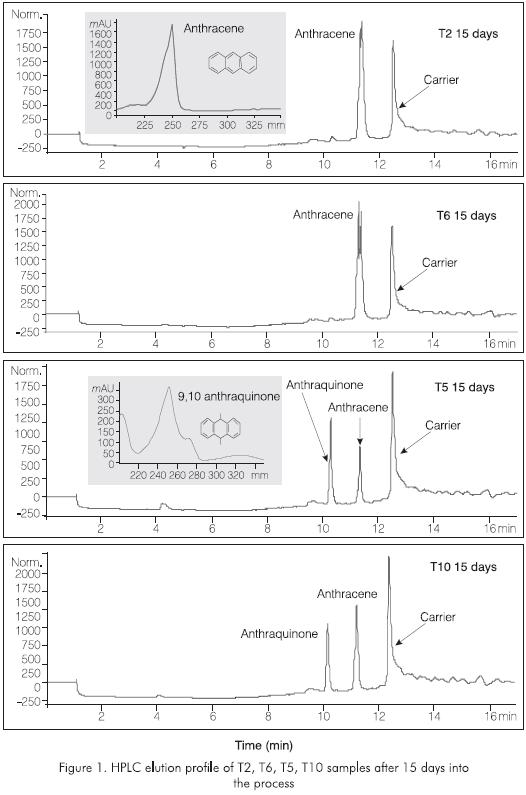
A metabolite peak that eluted before the anthracene peak was also observed. The peak location corresponded to the compound -anthraquinone, as indicated by comparison with the library spectra. In order to confirm this identification, the sample was subjected to mass spectroscopy. A molecular ion of 208 m/z (M+. 100), and fragments of 180 (-CO, 85), 152 (-2CO, 60), 76 (30) were observed thus confirming this identification (Figure 2).
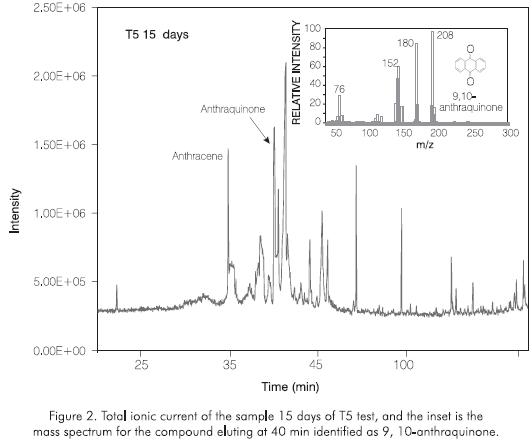
The identification of this metabolite is consistent with the results of studies carried out by Bezalel et al, 1996, and Fiel et al., 1992, Vazquez-Duhalt, R, et al, 1994, in which it was demonstrated that some white rot fungi, among them P. ostreatus, P. chrysosporium, metabolize anthracene by means of the production of anthraquinone, due to its relatively low ionization potential (Pickard, M., et al, 1999. The biological transformation of anthracene into anthraquinone should not be considered as an undesirable outcome because a number of bacteria and some fungi may mineralize this metabolite more easily (Bezalel et al, 1997).
In the preceding evaluation of the biological processes, performance was measured by the quantification of anthracene residues overtime. However, by comparing the chromatograms (T5 and T10) after 30 days into the process (Figure 3), it was observed that the quantity of anthraquinone has increased. Furthermore, two new chromatographic peaks were also observed. These new peaks suggest formation of degradation products that until now have not been identified. Based on a review of a bibliographic reference (Bezalel et al, 1996), one of the peaks may be anthracene trans-1,2-dihydrodiol (Figure 3). Vazquez-Duhalt. R, et al, 1994 reported a GC retention time and mass psectrum as an authentic standard of 9,10 anthraquinone like product resulting from the lignin peroxidase reactions.
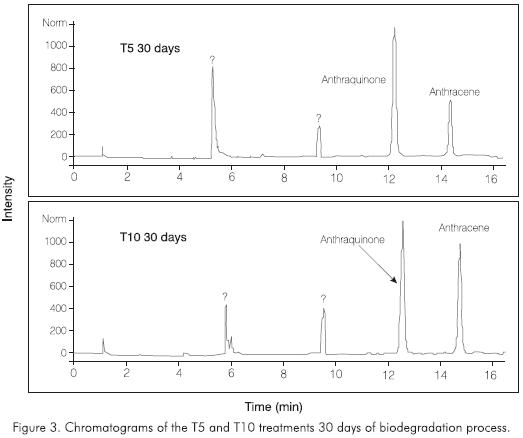
CONCLUSIONS
-
An initial anthracene concentration of 79.3 mg/kg in soil was reduced by 89.8% in 30 days by applying a process involving the application of the white rot fungus Pleurotus ostreatus plus compost. After 45 days of incubation using this assay, the concentration of anthracene was below the detection limit for the analytical method (high performance liquid chromatography).
-
The maximum rate of anthracene removal was observed after 15 days (67.3 to 74.4%). These removal rates occurred at the time during which the fungal cells were presumably generating the highest amounts of ligninolytic enzyme in cultures in solid substrate.
ACKNOWLEDGMENTS
The authors express sincere appreciation to both Beatriz Suárez (Chemical Technician), and Ivan Ramirez for their contributions in conducting the experiments as well as ECOPETROL -ICP for its financial support.
REFERENCES
Cerniglia, C.E., W.L. Cambell, P. Fu., Freeman, J. and Evans, F, 1990. "Stereoselective fungal metabolism of methylated anthracenes". Appl. Environ. Microbiol, 56 (3): 661-668. [ Links ]
Bezalel, L., Hadar Y., Fu, P.P. Freeman JP. and Cerniglia C. E., 1996. "Metabolism of Phenanthrene by the white rot fungus Pleurotus ostreatus". Appl. Environ. Microbiol, 62 (7): 2547-2553. [ Links ]
Bezalel, L., Hadar, Y. and Cerniglia, C.E., 1996. "Mineralization of polycyclic aromatic hydrocarbons by the white rot fungus Pleurotus ostreatus". Appl. Environ. Microbiol, 62(1): 292-295. [ Links ]
Bezalel, L., Hadar, Y. and Cerniglia, C.E., 1997. "Enzymatic mechanism involved in Phenanthrene degradation by the white rot fungus Pleurotus ostreatus". Appl. Environ. Microbiol, 63 (7): 2495-2501. [ Links ]
Eggen, T., 1999. "Bioremediation of recalcitrant aromatic organic pollutans with white rot fungi". Doctor Scientiarum Theses/Norges landbrukshøgskole. Norges landbrukshøgskole, Institutt for jord- og vannfag, s. Ås 2000, ISBN 82-575-0409-2,33 :125. [ Links ]
Field, J.A., De Jong., E., Feijoo, G. and A.M De Bont, 1992. "Biodegradation of polycyclic aromatic hydrocarbons by new isolates of white-rot fungi". Appl. Environ. Microbiol, 58:2219-2226. [ Links ]
Kerem, A. and Hadar, Y., 1995. "Effect of Manganese on preferential degradation of lignin by Pleurotus ostratus during solid-state fermentation". Appl. Environ. Microbiol, 61(8):3057-3062. [ Links ]
Maue, G. and Dott, W., 1995. "Degradation tests with PAH-metabolizing soil in situ bioremediation". In: Hinchee, R.E., Douglas and Ong, S.K., Eds Battelle Press, Columbus, OH., 127-133. [ Links ]
Pickard, M., Roman, R., Tinoco, R. and Vazquez-Duhalt, R, 1999. "Polycyclic aromatic hydrocarbon metabolism by white rot fungi and oxidation by coriolopsis gallica UAMH 8260 Lacease". Appl. Environ. Microbil, 65 (9): 3805-3809. [ Links ]
Sarkar, S., Martinez, A.T. and Martínez, M.J., 1997. "Biochemical and molecular characterization of a Manganese peroxidase isoenzyme from Pleurotus ostreatus". Biochim. Biophys. Acta, 1339 (1): 23 - 30. [ Links ]
Sutherland, I, Raffi, K, Khan, A. and Cerniglia, C.E., 1995. "Mechanisms of polycyclic aromatic hydrocarbon degradation". In: L.Y. Young and C.E. Cerniglia ed, microbial transformation and degradation of toxic org chem., Wiley - Liss, New York, N. Y. [ Links ]
Vargas, M. C, Ramírez, N., Rueda, S. and Sánchez, K, 1996. "Isolation of microorganism with capability to degrade polycyclic aromatic hydrocarbons (PAH's)". CT&F Ciencia Tecnología y Futuro, 1(2): 45 - 53. [ Links ]
Vazquez-Duhalt, R., Westlake, D.W. and Fedorak, M., 1994. "Lignin Peroxidase Oxidation of Aromatic Compound in System Containing Org. Solvents". Appl. and Environ. Microbiol, 60 (2): 459-466. [ Links ]
White, R. and Lamar, R, 1999. "Degrading ability of white rot fungi". Soil & Groundwater cleanup. Dec, 11-16. [ Links ]














